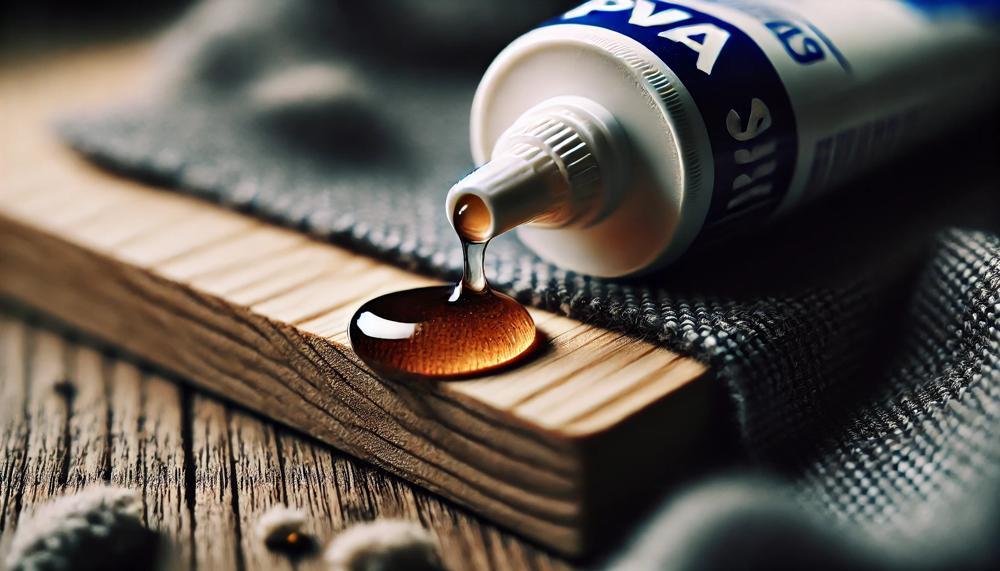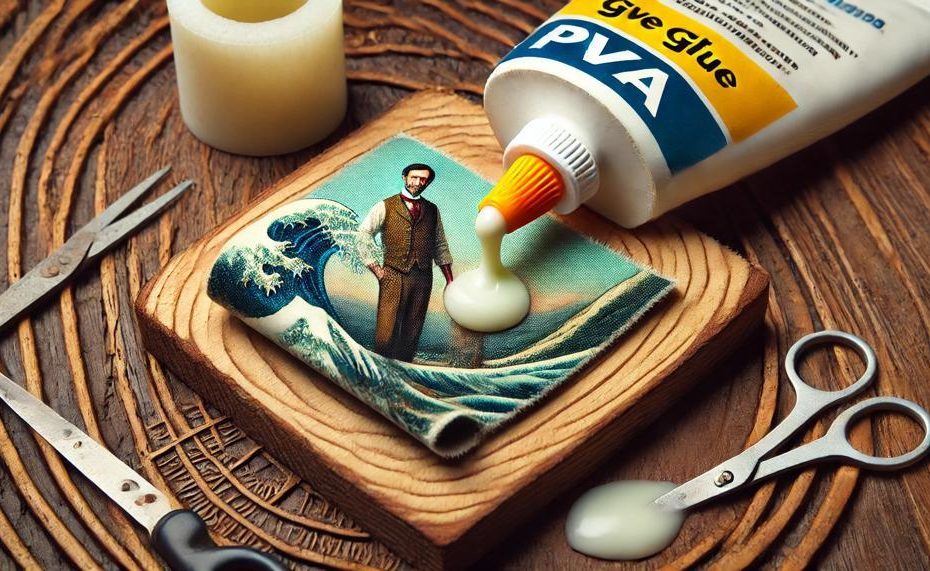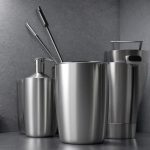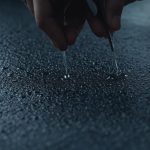The answer is a straightforward “Yes.” PVA glue, or polyvinyl acetate, is a popular choice for various crafts and woodworking projects due to its versatility and strong bonding capabilities. Whether you’re creating upholstered furniture, decorative wall art, or enhancing wooden surfaces with fabric, PVA glue can be your reliable adhesive.
Key Takeaways:
- PVA glue, a water-based adhesive made from polyvinyl acetate emulsion, offers strong bonding properties ideal for fabric-to-wood applications.
- Preparation is key: Ensure surfaces are clean and the wood is lightly sanded to create a textured base for better adhesion.
- Apply the glue evenly to both the fabric and wood surfaces, allowing it to become tacky before firmly pressing them together.
- Consider using clamps or heavy objects to reinforce the bond while the glue sets.
- Benefits include quick drying time, ease of application, and durability against everyday wear and tear.
In this article, we’ll delve deeper into why PVA glue is suitable for this purpose, provide step-by-step instructions for achieving the best results, and explore tips for maximizing adhesion strength.
Whether you’re a seasoned crafter or tackling your first DIY project, mastering the art of using PVA glue for fabric-to-wood bonding opens up a world of creative possibilities.
Let’s get started.
Table of Contents
What is PVA Glue?
PVA glue, or polyvinyl acetate glue, is a versatile, water-based adhesive commonly used in woodworking, crafts, and fabric projects. It’s celebrated for its strong bonding properties, ease of use, and safety. Here’s a detailed look at how it functions, especially in adhering fabric to wood:
Composition and Properties
- Polyvinyl Acetate Emulsion: PVA glue is made from polyvinyl acetate emulsion, a synthetic polymer that forms strong, flexible bonds.
- Water-Based: This feature allows for easy cleanup with water before the glue dries and makes it safe for a variety of surfaces.
- Non-Toxic and Odorless: Ideal for household use, PVA glue is both non-toxic and odorless, ensuring a safe working environment.
Application on Fabric and Wood
- Surface Preparation: Clean both the fabric and wood surfaces. Sanding the wood lightly can help the glue adhere better by creating a rough texture.
- Applying the Glue: Apply an even layer of PVA glue to both surfaces. Ensure not to oversaturate the fabric, as this can lead to a weak bond.
- Bond Formation: Allow the glue to become tacky before pressing the fabric onto the wood. This helps in achieving a stronger bond.
- Clamping: Use clamps or heavy objects to press the fabric and wood together. This ensures the glue sets properly and forms a durable bond.
- Drying Time: PVA glue typically dries within 24 hours, but it’s best to leave it undisturbed for a stronger hold.
Advantages
- Strong Bond: Once dried, PVA glue forms a robust bond that can withstand wear and tear.
- Flexible and Safe: Suitable for a wide range of fabrics including cotton, silk, and even leather.
- Easy to Use and Clean: Simple application process and easy cleanup with water.
Limitations
- Drying Time: Not ideal for time-sensitive projects due to its drying time.
- Not Waterproof: While it offers some water resistance, PVA glue is not fully waterproof. For outdoor or high-moisture environments, consider other adhesives like polyurethane or epoxy.
Practical Uses
- Crafts and DIY Projects: Perfect for fabric art, quilting, and other crafts where fabric needs to be adhered to wood.
- Household Repairs: Useful for minor upholstery repairs and decorative projects.
Comparison with Other Adhesives
| Adhesive Type | Advantages | Disadvantages |
| PVA Glue | Easy to use, non-toxic, strong bond for most fabrics | Not waterproof, longer drying time |
| Polyurethane | Waterproof, very strong bond | Requires more preparation, can be messy |
| Epoxy | Extremely strong and durable, waterproof | Expensive, more complex application |
Can You Use PVA Glue to Stick Fabric to Wood?
Yes, you can use PVA glue to stick fabric to wood. PVA (polyvinyl acetate) glue, also known as white glue or school glue, is highly effective for this purpose due to its unique properties and composition.
| Property | Description |
| Composition | PVA glue is primarily made from water, vinyl acetate monomer (VAM), plasticizers, and preservatives. This combination makes it non-toxic, safe, and versatile. |
| Water-Based | Being water-based, PVA glue is easy to use and clean. However, it takes longer to dry compared to solvent-based adhesives, but this characteristic also contributes to its non-toxicity. |
| Penetration of Porous Surfaces | Both wood and fabric are porous materials. PVA glue’s low viscosity allows it to seep into these pores, creating a strong bond between the materials. |
| Cohesive Strength | PVA glue has high cohesive strength, meaning it holds together well under stress. This is crucial for maintaining the bond between fabric and wood without the glue breaking apart. |
| Flexibility | The flexibility of PVA glue allows it to expand and contract with the materials, making it suitable for projects exposed to temperature and humidity changes. |
| Moisture Resistance | Although PVA glue is water-based, it becomes resistant to moisture once dried, adding durability to the bond in various conditions. |
How Does PVA Glue Work?
PVA glue works by using the properties of vinyl acetate monomer. When applied to surfaces, the water in the glue evaporates, leaving behind sticky VAM molecules.
These molecules bond together as they dry, forming a strong, durable link between the fabric and wood. This bond strengthens over time as VAM molecules continue to crosslink, creating a more solid structure.
Key Benefits of Using PVA Glue for Fabric and Wood
- Non-Toxic and Safe: Ideal for children’s crafts and projects that require safety and ease of use.
- Strong and Durable Bond: Creates a lasting bond that gets stronger over time.
- Flexibility and Cohesive Strength: Withstands movement and environmental changes without losing integrity.
For detailed information on PVA glue and its applications, you can refer to this Wikipedia article on PVA glue.
PVA glue is a reliable and versatile adhesive for bonding fabric to wood, making it a staple in arts and crafts.
Preparing the Fabric and Wood for Glue Application
To achieve a strong and durable bond when adhering fabric to wood, proper preparation of both surfaces is essential. Here are the necessary steps:
Preparing the Wood Surface
Clean the Surface:
- Remove any dust, dirt, or debris using a damp cloth.
- Ensure the surface is completely dry before proceeding.
Smooth the Surface:
- Sand the wood to remove any rough spots, splinters, or imperfections.
- Use fine-grit sandpaper for a smooth finish.
Remove Residues:
- Wipe the surface with a tack cloth to eliminate any sanding dust.
Optional Sealing:
- If the wood is porous, consider applying a primer or sealer to create a non-porous surface, which helps in better adhesive bonding.
Preparing the Fabric
Clean the Fabric:
Wash the fabric to remove any dirt, oils, or manufacturing residues.

Ensure the fabric is completely dry before use.
Iron the Fabric:
Iron the fabric to remove wrinkles and ensure a smooth surface.
This helps in achieving a neat and even application.
Trim to Size:
Cut the fabric to the desired size, allowing a little extra margin to work with during the application process.
Test for Adhesive Compatibility:
Test a small piece of fabric with the chosen adhesive on a scrap piece of wood to ensure compatibility and adhesion strength.
Applying the Glue
To properly apply PVA glue and ensure a strong bond between fabric and wood, follow these steps:
| Step | Description | Tips |
| Prepare Materials | Clean and smooth both surfaces. | Remove dust, dirt, and oils. |
| Test Compatibility | Test a small area for adhesion. | Ensure materials are suitable for PVA glue. |
| Apply Glue Evenly | Spread a thin layer on the wood. | Avoid over-application. |
| Position Fabric | Place fabric on glued surface. | Smooth out wrinkles. |
| Apply Pressure and Clamp | Clamp surfaces together. | Leave for recommended time. |
| Clean Excess Glue | Wipe off excess glue. | Use a damp cloth. |
| Allow Full Cure | Let glue cure fully. | Check manufacturer’s instructions. |
| Optional Sealing | Seal bonded area for durability. | Apply after full cure. |
Drying and Curing Time
When using PVA glue to stick fabric to wood, the drying time can range from 30 minutes to a few hours, depending on the environmental conditions such as humidity and temperature. However, to ensure a solid bond, it is recommended to allow the glue to cure completely, which typically takes around 24 hours. For optimal results, the bond should be left undisturbed during this period.
Factors Affecting Drying and Curing Time
| Factor | Impact on Drying Time | Details |
| Environmental Conditions | Variable | Higher humidity and lower temperatures can extend drying time, while dry and warm conditions can accelerate it. |
| Fabric Type | Moderate | Thicker fabrics may require more drying time due to greater absorption. |
| Glue Layer Thickness | Significant | Thicker layers of glue will take longer to dry and cure. |
| Wood Moisture Content | Variable | Dry wood may absorb moisture from the glue, speeding up the drying process. |
Practical Tips for Efficient Drying
- Clamping: Ensure that the fabric is securely clamped to the wood to avoid air pockets and ensure even pressure. This helps in achieving a uniform bond.
- Ventilation: Good airflow around the glued area can aid in faster drying. Place the bonded items in a well-ventilated area but avoid direct sunlight, which might cause the glue to dry unevenly.
- Temperature: Maintaining a moderate temperature of around 20°C (68°F) is ideal for the drying process.
Benefits of Using PVA Glue to Stick Fabric to Wood
When considering adhesives for attaching fabric to wood, PVA (polyvinyl acetate) glue stands out for several reasons. Here’s a detailed look at the advantages of using PVA glue compared to other types of adhesives:
| Advantage | Description | Comparison to Other Adhesives |
| Strong Adhesion | PVA glue creates a robust bond between fabric and wood, often stronger than the fabric itself. Ideal for heavy fabrics and large wood pieces, ensuring longevity without peeling or detachment. | Other adhesives like spray adhesives or hot glue might not offer the same strength, leading to potential peeling over time. |
| Versatility | Works with a variety of fabrics (cotton, wool, polyester, silk) and woods (pine, oak, plywood), making it suitable for diverse projects. | Specialised adhesives may only work with specific materials, limiting their use. |
| Dries Clear | Once dried, PVA glue is transparent, perfect for projects with light-colored materials where visible glue could be unsightly. | Epoxy or polyurethane glues often dry with a noticeable tint, potentially marring the project’s appearance. |
| Easy Cleanup | Water-based nature allows for simple cleanup with a damp cloth before the glue dries, preventing damage to delicate fabrics. | Solvent-based glues require harsh chemicals for cleanup, which can be harmful and cumbersome. |
| Non-Toxic | PVA glue is safe for use by both adults and children, emitting no harmful fumes and having no strong odour, suitable for indoor use. | Many other adhesives emit strong fumes and are toxic, necessitating proper ventilation and precautions. |
| Cost-Effective | Affordable and widely available, PVA glue is an economical choice, especially beneficial for large or multiple projects. | Specialty glues can be significantly more expensive, increasing the project’s cost. |
| Ease of Use | Simple application methods (brush, roller, fingers) and easy correction of mistakes due to its water-based formula make it user-friendly, even for beginners. | Other adhesives might require specific tools or techniques, making them less accessible to novice users. |
Conclusion
PVA glue is a highly effective adhesive for sticking fabric to wood, making it a favorite among crafters and DIY enthusiasts. This water-based glue, known for its strong bonding properties and ease of use, ensures a durable and lasting connection between these materials. By preparing both the fabric and wood surfaces meticulously—cleaning, sanding, and applying a consistent layer of glue—you can achieve optimal results.
One of the key benefits of PVA glue is its flexibility, allowing it to accommodate the natural expansion and contraction of wood and fabric. Additionally, while the glue takes some time to dry, it becomes resistant to moisture once cured, enhancing the durability of your projects. Using clamps or heavy objects to press the materials together during the drying process further reinforces the bond.
While PVA glue isn’t fully waterproof, making it less suitable for outdoor use, its non-toxic and odorless nature makes it ideal for indoor applications, including upholstered furniture, decorative art, and various household repairs. Its ability to penetrate porous surfaces and create a strong, cohesive bond makes PVA glue an indispensable tool in any craftsperson’s toolkit.






